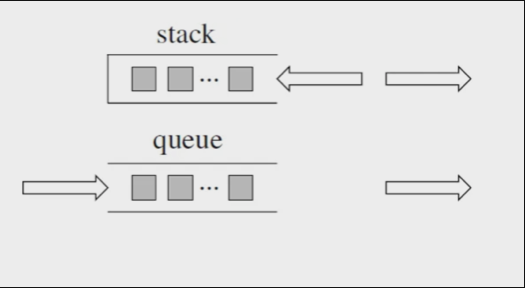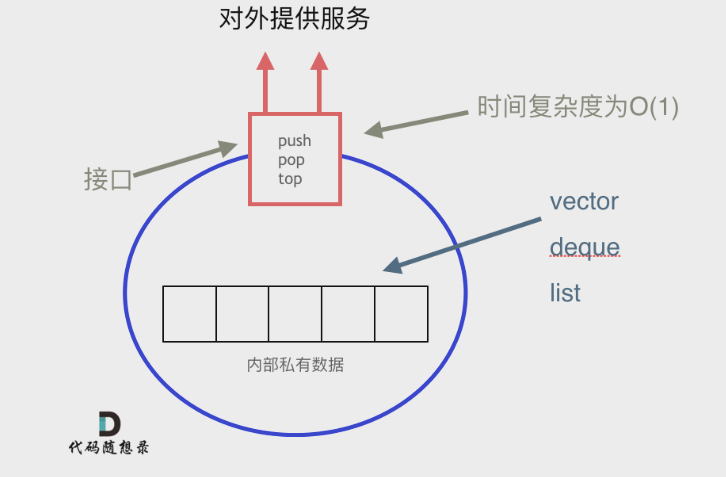栈和队列
本篇为个人笔记,内容或有错误。
图片部分源于代码随想录,侵删。
栈和队列不为人知的一面
栈是先进后出,队列是先进先出:

20220616145417
基础知识
栈先进后出,提供push 和 pop 等等接口,所有元素必须符合先进后出规则,所以栈不提供走访功能,也不提供迭代器(iterator)。 不像是set 或者map 提供迭代器iterator来遍历所有元素。
栈是以底层容器完成其所有的工作,对外提供统一的接口,底层容器是可插拔的(也就是说我们可以控制使用哪种容器来实现栈的功能)。
所以STL中栈往往不被归类为容器,而被归类为container adapter(容器适配器)。
那么问题来了,STL 中栈是用什么容器实现的?
从下图中可以看出,栈的内部结构,栈的底层实现可以是vector,deque,list 都是可以的, 主要就是数组和链表的底层实现。
常用的SGI STL,如果没有指定底层实现的话,默认是以deque为缺省情况下栈的低层结构。
deque是一个双向队列,只要封住一段,只开通另一端就可以实现栈的逻辑了。
SGI STL中 队列底层实现缺省情况下一样使用deque实现的。
也可以指定vector为栈的底层实现,初始化语句如下:
std::stack<int, std::vector<int> > third; // 使用vector为底层容器的栈
对应的队列的情况是一样的。
队列中先进先出的数据结构,同样不允许有遍历行为,不提供迭代器, SGI STL中队列一样是以deque为缺省情况下的底部结构。
也可以指定list 为起底层实现,初始化queue的语句如下:
std::queue<int, std::list<int>> third; // 定义以list为底层容器的队列
所以STL 队列也不被归类为容器,而被归类为container adapter( 容器适配器)。
用栈模拟实现队列
class MyQueue {
public:
stack<int> stIn;
stack<int> stOut;
/** Initialize your data structure here. */
MyQueue() {
}
/** Push element x to the back of queue. */
void push(int x) {
stIn.push(x);
}
/** Removes the element from in front of queue and returns that element. */
int pop() {
// 只有当stOut为空的时候,再从stIn里导入数据(导入stIn全部数据)
if (stOut.empty()) {
// 从stIn导入数据直到stIn为空
while(!stIn.empty()) {
stOut.push(stIn.top());
stIn.pop();
}
}
int result = stOut.top();
stOut.pop();
return result;
}
/** Get the front element. */
int peek() {
int res = this->pop(); // 直接使用已有的pop函数
stOut.push(res); // 因为pop函数弹出了元素res,所以再添加回去
return res;
}
/** Returns whether the queue is empty. */
bool empty() {
return stIn.empty() && stOut.empty();
}
};
用队列模拟实现栈
class MyStack {
public:
queue<int> que1;
queue<int> que2;
MyStack() {
}
void push(int x) {
que1.push(x);
}
int pop() {
if (!this->empty()) {
while (que1.size() > 1) {
que2.push(que1.front());
que1.pop();
}
int result = que1.front();
que1.pop();
while (!que2.empty()) {
que1.push(que2.front());
que2.pop();
}
return result;
}
return 0;
}
int top() {
return que1.back();
}
bool empty() {
return que1.empty() && que2.empty();
}
};
/**
* Your MyStack object will be instantiated and called as such:
* MyStack* obj = new MyStack();
* obj->push(x);
* int param_2 = obj->pop();
* int param_3 = obj->top();
* bool param_4 = obj->empty();
*/
有效括号问题
class Solution {
public:
bool isValid(string s) {
stack<char> sta;
for (int i = 0; i < s.size(); i++) {
if (s[i] == '(') sta.push(')');
else if (s[i] == '[') sta.push(']');
else if (s[i] == '{') sta.push('}');
else if (sta.empty() || sta.top() != s[i]) return false;
else sta.pop();
}
return sta.empty();
}
};